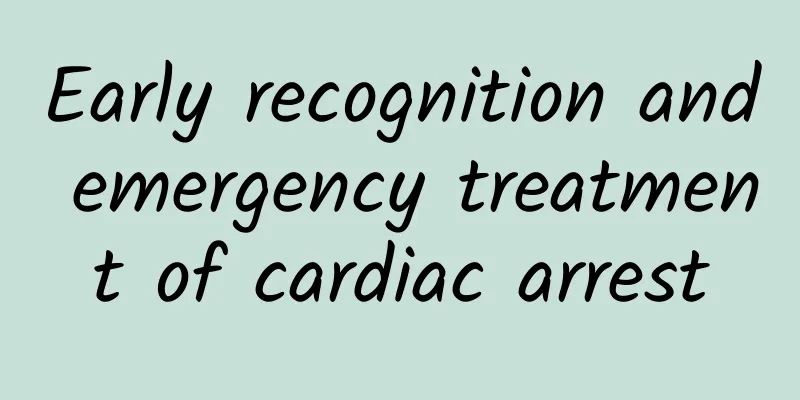Early recognition and emergency treatment of cardiac arrest

|
Author: Guo Yanli, The First Affiliated Hospital of Zhengzhou University Reviewer: Deng Wenjing, Chief Physician, First Affiliated Hospital of Zhengzhou University Cardiac arrest is a sudden, life-threatening medical emergency in which the heart stops beating, resulting in the interruption of effective blood circulation. Cardiac arrest can occur at any time and in any place, so it is important to know how to recognize it early and provide emergency treatment. 1. Early recognition of cardiac arrest 1. Loss of consciousness The patient suddenly loses consciousness and does not respond to external stimuli. 2. The patient has no breathing or abnormal breathing and stops breathing or has a dying sigh-like breathing. 3. Pulse disappears. No pulse can be felt in the carotid artery or wrist artery. 4. Skin color changes Due to impaired blood circulation, the skin may appear pale or cyanotic. Second, emergency treatment of cardiac arrest 1. Call the emergency number immediately. After confirming that the patient has cardiac arrest, call 120 emergency number immediately and clearly inform the operator of the patient's condition and location. 2. Cardiopulmonary resuscitation (CPR) While waiting for the ambulance to arrive, you should immediately start cardiopulmonary resuscitation (CPR). CPR includes chest compressions and artificial respiration. (1) Chest compression: Have the patient lie flat on a hard surface. The rescuer kneels on one side of the patient and places the base of one palm on the junction of the middle and lower 1/3 of the patient's sternum. The base of the other palm is placed on top of the first hand. Both elbows are straightened and the upper body strength is used to press vertically downward. The compression frequency is 100 to 120 times per minute and the compression depth is at least 5 cm. (2) Artificial respiration: After 30 chest compressions, perform 2 artificial respirations. Gently tilt the patient's head back, open the airway, pinch the patient's nose, and perform mouth-to-mouth respiration. Figure 1 Copyright image, no permission to reprint 3. Use an automated external defibrillator If an automated external defibrillator (AED) is available on site, it should be used immediately. AED is a portable medical device that can diagnose specific arrhythmias and deliver electric shocks for defibrillation. It is a medical device that can be used by non-professionals to rescue patients with cardiac arrest. The steps for use are as follows. (1) Turn on the AED: Turn on the power of the AED. (2) Apply electrodes: Apply the electrodes to the patient's chest according to the instructions of the AED. (3) Heart rhythm analysis: AED will automatically analyze the patient's heart rhythm to determine whether electric shock is needed. (4) Electric shock defibrillation: If the AED indicates that an electric shock is needed, make sure no one is touching the patient and then press the shock button. Figure 2 Copyright image, no permission to reprint 4. Continue CPR During the AED analysis and shock process, do not interrupt CPR. If the AED indicates that shock is not needed, continue CPR. 5. Wait for professional rescue While performing CPR, wait for professional medical personnel to arrive. Once they arrive on the scene, follow their instructions. 3. Preventing Cardiac Arrest Although cardiac arrest often occurs suddenly, it can actually be prevented by adjusting your lifestyle and eating habits. 1. Eat a healthy and balanced diet and reduce the intake of high-fat, high-salt and high-sugar foods. 2. Exercise moderately. Engage in moderate physical activity regularly. 3. Quit smoking and limit alcohol intake. Avoid smoking and limit alcohol intake. 4. Get regular physical exams Get regular heart health checks. 5. Manage Stress Learn effective stress management techniques. IV. Conclusion Cardiac arrest is a serious medical emergency, but early recognition and proper emergency treatment can greatly improve the patient's survival rate. Cardiopulmonary resuscitation methods and the use of automated external defibrillators (AEDs) are basic skills that everyone should master. At the same time, it is also very important to prevent the occurrence of cardiac arrest through a healthy lifestyle. Time is life. When cardiac arrest occurs, every second is crucial. Through this article, I hope you can master the knowledge of early identification and emergency treatment of cardiac arrest, and provide protection for the life safety of yourself and others. |
<<: The "AI Revolution" in Clinical and Radiology Departments: Opening a New Era of Smart Healthcare
>>: [Medical Q&A] How to care for children who have the flu?
Recommend
What medicine should I take to stop bleeding during menstruation?
There are many ways for women to have irregular m...
How many days does it take to get an abortion while pregnant?
In daily life, many women have signs of unwanted ...
Why are my legs weak during menstruation?
When menstruation comes, since the human body is ...
What medicine is good for girls with dysmenorrhea
Almost 70% of girls have dysmenorrhea in life. So...
Pregnant women eat this and the fetus dies in the womb
What foods can’t pregnant women eat? Pregnant wom...
Can I eat olives during my period?
For women who are menstruating, there are so many...
How to relieve postpartum urethral pain caused by urethritis
Many people find that there are many troubles aft...
What happens if a woman has lumps in her armpits after giving birth?
After giving birth, the mother's body is very...
How many days after the fertilized egg implants can pregnancy be detected?
Many young couples love children very much, so th...
At what age do women reach their sexual peak?
Sexual intercourse is a condiment between husband...
What to do about menopausal amenorrhea? Women can do this!
The most direct manifestation of menopause for wo...
The benefits of eating flaxseed for women
Flax seeds contain two of the most important subs...
What is the normal color of menstruation?
Menstruation is a physiological need that every w...
Caesarean section, 20 days after sex, she died
It is very bad for women to resume sexual life to...









